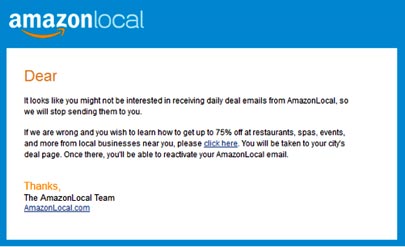The "take-away close" is not something I learned about from my days as a marketer, but from my tenure as a mother. My husband, a sales guy at heart, used to use the take-away close during his days
as a stockbroker: “Sure , Steve, I understand. You don’t need an extra $500,000 in the bank -- which is exactly what you could be missing by passing up this investment opportunity.
Not a problem at all.” It wasn’t until our kids were able to talk that I learned about this sales technique -- and it works like a charm! “You don’t want to go for ice cream?
That’s OK -- we can put your dinner in the trash.” (I know, we’re awful, but with three little ones running around at dinnertime, you do whatcha gotta do!) For the first time
yesterday, I saw it in an email program. Ahhh, AmazonLocal.

advertisement
advertisement
Amazon has introduced a new twist on the reengagement campaign. Instead of highlighting that you are missed, they are telling you that they are
not sending you email anymore, because you just don’t seem to want to receive 75% off at local restaurants, spas, events and more. Why would you want to save money in this economy, after
all?
This message so impressed a few folks in our office, they actually sent it around to highlight the approach. It got me thinking. Does the take-away close really work in email? I
don’t have any interaction with this brand’s email program, nor have I ever had a client try this approach -- but that begs the question about its effectiveness. Here are a couple of
thoughts based on my limited insight into this program:
- Is the subscriber really uninterested? It’s unclear what period of time the recipient has been inactive
before receiving this communication, but I would have to believe it was far longer than the average customer. In one example, the colleague who received this said he didn’t even have a
recollection of opting in. If this is a tactic that you would like to leverage, be pretty darn sure the subscriber doesn’t want your email. It might be that they haven’t opened in a while
or clicked, but could be actively leveraging your website. The point here is to have all of your facts before you start accusing folks of not liking you anymore. I am sure that Amazon has done its due
diligence here.
- Does the punishment fit the crime? Should subscribers just be banished from the email realm -- or should you give them one more chance? In this
example, Amazon has deactivated the account, and consumers have to jump through some technical hoops to get their account turned back on. On one hand, anyone who does click through and
reactivate – I would guess they are pretty interested in getting your messaging (which begs the question of why they got this in the first place). But if subscribers are more voyeuristic and
just waiting for the right deal to come along , you will likely have lost them. Test it out. See if it works for your business -- as I’m sure Amazon did.
- Does the positioning fit our brand? Not all brands have a culture or a tone to support this type of message to the customer. Be sure that leveraging the take-away close for your
reengagement messages isn’t going to leave a bad taste in the subscriber's mouth. This is a viral world, and word can get around pretty quickly if someone gets annoyed by this
tactic.
More than anything, my interest is piqued. I really do wonder about the logistics and performance of this program, as it truly did stand out. But according to those I spoke to
who received it, Amazon was correct: they no longer wanted the company’s email messages. So what is the measurement of success here? Reengagement, or successful suppression of unengaged
customers? What do you all think?